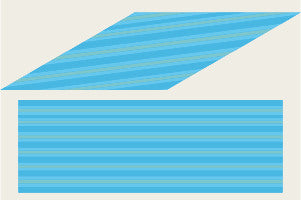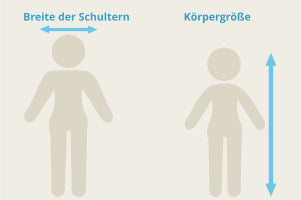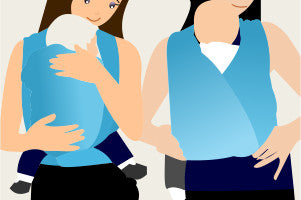Ja, das Tragetuch ist auch für Neugeborene geeignet. Das Baby sollte aufrecht und symmetrisch im Tuch getragen werden mit angehockten Beinen.
Die häufigsten zwei Formen eines Tragetuchs ist das Parallelogramm und das Rechteck. Ein rechteckiges Tragetuch benötigt mehr Stoff als ein Parallelogramm, da die Enden des Parallelogramms schmal zulaufen und der Knoten kleiner ist als der eines rechteckigen Tuchs.
Tipp: Ein rechteckiges Tragetuch muss länger sein als ein Tragetuch in Paralellogramm-Form.
Hinweis: Wir bieten keine rechteckigen Tragetücher an!
Die Körpermaße spielen hierbei eine große Rolle - nicht nur die Konfektionsgröße, sondern auch die Breite der Schultern. Eine große Frau mit breiteren Schultern benötigt automatisch mehr Stoff als eine kleine Frau mit einer sehr schmalen Statur.
Hierfür werden Online viele Größentabellen angeboten, die aber leider auch nicht exakt sind.
Tipp: Lassen Sie sich von erfahrenen Trageberaterinnen beraten.
Es gibt viele verschiedene Bindeweisen, die eine unterschiedliche Menge an Stoff benötigen.
Für eine Rucksack-Trage wird beispielsweise weniger Stoff benötigt als für die Wickelkreuztrage.
Tipp: Wer sich hier unsicher ist, sollte sich vor dem Kauf die Meinung von einer Trageberatung einholen oder nach dem Kauf mit dem Tragetuch die Beratung aufsuchen.
Damit Ihr Kind eine gesunde Körperhaltung beim Tragen hat, müssen einige Dinge beachtet werden. Um selbst zu kontrollieren, ob die Bindung des Tragetuchs korrekt ist, haben wir für Sie eine Checkliste angefertigt:
Ist es die richtige Höhe?
Die richtige Höhe ist gegeben, wenn Sie Ihr Kleines problemlos auf den Kopf küssen können.
Genauer: Ihr Kinn sollte auch beim Stolpern nicht an den Kopf des Babys kommen.
Wie fest muss die Bindung sein?
Das Tragetuch sollte straff gebunden sein, damit das Baby ausreichend gestützt wird. Bei Neugeborenen muss der Kopf zusätzlich gestützt werden, da Kinder bis zum 3. Monat den Kopf nicht richtig halten können. Bei einem älteren Baby ist die Bindung straff genug, wenn das Tragetuch einen guten Halt gibt, aber gleichzeitig das Drehen des Kopfes möglich ist.
Ein einfacher Test: Beugen Sie sich nach vorn. Wenn das Baby mit Ihnen in Kontakt bleibt, sitzt das Tuch fest genug. Fällt das Baby von Ihnen weg ins Tuch, bitte noch einmal nachziehen.
Sitzt Ihr Schatz korrekt?
Ihr Baby sollte beim Tragen stets in der Anhock-Spreiz-Haltung sein. Hier kommt es auf die Position der Beine an. Dabei sollen die Kniekehlen einen Winkel von 90 Grad bilden (Spreizung). Die Knie des Babys sollten höher sein als der Po (Anhockung). Diese Haltung unterstützt die Reifung der Hüfte.
Sitzt Ihr Schatz bequem?
Das Tragetuch sollte bis an die Kniekehlen Ihres Schatzes reichen. Achten Sie darauf, dass auch nichts scheuert.
Bilden Träger und Tragling eine Gewichtseinheit?
Ihr Schatz sollte nicht an Ihnen hängen, sondern hockend im Tuch eher schwingen als sitzen. Ist das der Fall, bilden Sie eine Gewichtseinheit.
Ist Ihr Kind entsprechend der Temperatur gekleidet?
Im Winter muss darauf geachtet werden, dass Ihr Kind nicht auskühlt. Zwar wärmt das Tragetuch zusätzlich, dennoch sollte man auf ausreichend Kleidung achten. Wir empfehlen zusätzliche Socken aus Wolle, Stulpen und eine warme Mütze!
Im Sommer sollten weder Sie noch Ihr Kind schwitzen. Bei höheren Temperaturen ist oftmals ein Body unter dem Tragetuch ausreichend. Ein Mulltuch zwischen Ihnen und Ihrem Baby saugt den Schweiß auf. Eine luftige Bindeweise wie das Känguru und Rucksack ist hilfreich! Bei sehr hohen Temperaturen, vor allem um die Mittagszeit, sollten Sie sich überlegen, ob Sie nicht eventuell auf das Tragen mit Tragetuch verzichten.
Im Vorfeld wurde bereits erwähnt, dass ein Tragetuch für Mütter unterschiedlicher Kulturen persönlicher und bequemer ist. In wie weit sich das auch auf Ihren Alltag übertragen lässt, zeigen wir Ihnen anhand folgender Punkte:
Nähe zum Kind - Bessere Bindung
Wenn Sie ein Tragetuch nutzen, tragen Sie Ihr Kind dicht bei sich. Das fürt dazu, dass Sie intuitiver auf die Signale Ihres Kindes reagieren können. Damit sind Sie in der Lage, durch bestimmte Bewegungen oder Geräusche Ihres Kindes die Bedürfnisse besser zu "lesen".
Stärkung des Immunsystems
Es wurde mehrfach wissenschaftlich bewiesen, dass die Nutzung eines Tragetuchs das Immunsystem Ihres Kindes stärkt. Das liegt insbesondere an dem direkten Kontakt mit der Mutter oder dem Vater und damit an der Geborgenheit, die das Tragen mit sich bringt.
Beruhigende Wirkung
Viele Mütter nutzen das Tragetuch, um das Kind zu beruhigen. Manche Kinder werden in einer Hängematte sehr schnell ruhig, andere, wenn man sie im Auto durch die Gegend fährt, aber der Großteil der Kinder wird am besten durch die Nähe zu den Eltern und die gleichmäßigen Bewegungen beim Tragen beruhigt.
Hinweis: Die beruhigende Wirkung ist auch bei Verdauungsproblemen gegeben, da das Tragen mit Tragetuch auch die Verdauung des Babys fördert.
Verwendbar für Neugeborene bis zum Kleinkindalter
Wie oben bereits erwähnt, kann auch ein Neugeborenes in einem Tragetuch getragen werden. Hierbei sollte darauf geachtet werden, dass eine Wickelart bzw. Bindeweise verwendet wird, die den Kopf gut stützt.
Beispiele:
Ab der Geburt
Ab dem 3. Monat
Angenehmeres Reisen
Wenn Sie mit Ihrem Schatz auf Reise gehen möchten, stellt sich natürlich die Frage, welche Transportmöglichkeit die Beste ist.
Flug - Kinderwagen vs. Tragetuch
Ein größerer Kinderwagen muss als Sperrgepäck aufgegeben werden. Das kann je nach Airline enorme Kosten zusätzlich bedeuten. Das ist jedoch nicht alles, denn es haben schon viele Eltern berichtet, dass bei einem Flug der Kinderwagen beschädigt wurde. Mit einem Tragetuch müssen Sie sich über solche Dinge keine Sorgen machen.
Am Strand
Mit dem Tragetuch bekommen Sie nicht nur zusätzlichen Schutz vor der Sonneneinstrahlung, sondern auch eine bessere Mobilität. Im Sand kommt es vor, dass ein Kinderwagen nur schwer fortbewegt werden kann.
Eine neue Stadt erkunden
Viele Orte der Welt haben viele kleine Gassen, Passagen mit Treppen oder gar keine richtigen Gehwege. In solchen Städten ist die Nutzung eines Kinderwagens eine absolute Qual. Man kommt entweder gar nicht voran oder muss lange Umwege auf sich nehmen.
Diskret Stillen
Ein Tragetuch kann auch gut als Sichtschutz dienen. Mit einem Tragetuch müssen Sie nicht zwangsläufig eine Damentoilette aufsuchen, sondern können auch diskret in der Öffentlichkeit stillen.
Schutz vor Reizüberflutung
Mit Tragetüchern ist es einerseits möglich, Ihrem Schatz die Welt zu zeigen, und andererseits auch einfach Ihr Kleines vor einer Reizüberflutung zu schützen.
Damit Eltern und Kind von allen Vorteilen eines Tragetuchs profitieren können, muss das Tragetuch nicht nur optisch den Ansprüchen der Eltern gerecht werden, sondern auch sicher sein.
Ist es nicht egal, welches Tragetuch ich kaufe?
Nein, denn besonders in der heutigen Zeit, wo es unzählige Anbieter mit verschiedenen Qualitätsstandards gibt, muss man etwas mehr Zeit in die Suche des perfekten Tragetuchs investieren.
Es kommt durchaus vor, dass manche Hersteller zu dünne oder schlecht gewebte Tragetücher anbieten. Diese Tragetücher sind nicht zu empfehlen, da sie mit ihrer schlechten Verarbeitung ein gesundheitliches Risiko darstellen können.
Wenn Sie folgende 4 Punkte beachten, steht einem schönen Tragetucherlebnis nichts mehr im Wege!
1. Strapazierfähiger Tragetuchstoff - Webart und Material
Vor dem Kauf sollten Sie wissen, welche Webart verwendet und aus welchem Material das Tragetuch verarbeitet wurde. Der Stoff eines Tragetuchs muss dehnbar und dennoch strapazierfähig sein. Außerdem lassen sich nicht alle Stoffe gleichermaßen gut binden.
Welche Webart ist für ein Tragetuch geeignet?
Es gibt viele geeignete Webarten für ein strapazierfähiges Tragetuch. Wichtig ist dabei die Diagonalelastizität. Wir bieten Tragetücher mit folgenden Webarten an: Kreuzköper, Diamantköper, Fischgrat, Honeycomb und Double Weft.
Diese Stoffe sorgen dafür, dass das Tuch beim Tragen nicht reißt und sich gut an den Körper schmiegt.
Welches Material ist das Richtige?
Bei der Herstellung von Tragetüchern wird am häufigsten Baumwolle verwendet. Das liegt daran, dass Baumwolle ein geringes Allergiepotenzial hat, hautfreundlich, pflegeleicht, strapazierfähig und dehnbar ist.
2. Chemiefreies Tragetuch
Wie in allen Lebensbereichen versuchen wir beim Tragen unsere Kinder vor gefährlichen Einflüssen zu schützen. Damit Ihr Kind und Sie viel Freude mit einem Tragetuch haben können, sollten Sie darauf achten, dass das Tragetuch frei von Chemikalien ist, um allergische Reaktionen oder andere negative Folgen zu vermeiden.
Kann ich bei bekannten Herstellern von Tragetüchern bedenkenlos einkaufen?
Die uns bekannten großen Hersteller achten darauf und verkaufen nur schadstofffreie Tragetücher.
3. Gebrauchte Tragetücher kaufen
Beim Kauf eines gebrauchten Tragetuchs sollten Sie besonders genau hinsehen und auf Risse oder Löcher achten. Außerdem sollten Sie den Vorbesitzer fragen, ob das Tragetuch schon häufiger mit Weichspüler gewaschen wurde. Ist das der Fall, kann es sein, dass die Textilfasern angegriffen wurden und das Tragetuch damit eine geringere Stabilität bietet bzw. die Bindequalitäten gelitten haben.
4. Das perfekte Design für Sie
Wer sein Tragetuch oft nutzen möchte, stellt sich natürlich die Frage: “Welches Design passt langfristig zu mir?”
Falls Sie sich mit der Farbwahl unsicher sind, macht es Sinn in den Kleiderschrank zu schauen und entsprechend Ihrer Kleidung ein farblich passendes Tragetuch zu wählen. Wenn Sie ohnehin eher schwarze bzw. dunkle Kleidung tragen, passen natürlich alle erdenklichen Farben.
Besonders in den Großstädten wie Berlin, Hamburg oder München werden Sie auf der Straße Mütter mit gleichen Tragetüchern sehen. Wer ein Einzelstück haben möchte, kann selbst Hand anlegen oder sich ein Tragetuch von einem professionellen Schneider nähen lassen.
Wenn Sie ein Tragetuch selber nähen möchten, sollten Sie strapazierfähigen Tragetuchstoff verwenden. Diesen finden Sie in unserer Kategorie “Meterware”. Tragetuchstoff ist nicht sehr günstig, das liegt daran, dass die Webart durch die Diagonalelastizität aufwendig und speziell ist und Sie damit einen Stoff mit einer langen Nutzungsdauer erwerben.
Hinweis: Sollten Sie sich ein Tragetuch nähen lassen, ist es oft sinnvoll, den Tragetuchstoff im Vorfeld zu kaufen, um ein bisschen Geld zu sparen.
Bei guter Pflege kann ein Tragetuch viele Jahre auch für mehrere Kinder verwendet werden. Außerdem haben Sie dadurch die Möglichkeit, das Tragetuch mit nur geringem Geldverlust wieder zu verkaufen.
Keine Weichspüler verwenden
Weichspüler greifen die Fasern des Stoffes an und verändern die Bindeeigenschaften des Tragetuchs. Außerdem sind Weichspüler schädlich für die Umwelt.
Der Waschgang
Tragetücher aus reiner Baumwolle lassen sich normalerweise bis 60 Grad waschen. Dies ist aber nicht nötig. Damit Sie noch lange etwas von Ihrem Tragetuch haben, empfehlen wir materialschonende Waschgänge bis maximal 40 Grad und einer niedrigen Schleuderzahl mit maximal 900 Umdrehungen.
Es spricht auch nichts gegen eine Handwäsche bei 30 Grad mit Feinwaschmittel.
So wird Ihr Tragetuch sauber und behält alle positiven Eigenschaften bei.


